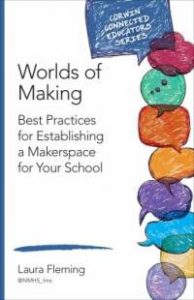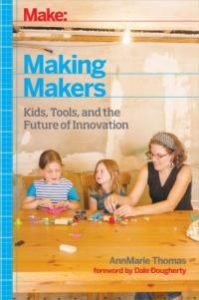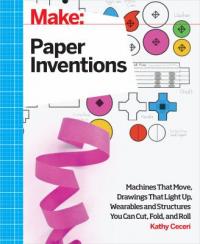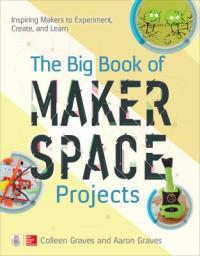A convergence of computer hackers and traditional artisans, Maker Movements and Maker Faires have garnered attention to the maker culture which has gained momentum for its technology-based extension of Do-It-Yourself culture. From designing to making to tinkering, consumers are turned makers as independent inventors, designers, and tinkerers. Learn how you can bring the maker movement to the classroom and inspire student makers with these new titles to OISE Library Collection.
Worlds of Making: Best Practices for Establishing a Makerspace for your School
By Laura Fleming

Author Laura Fleming, an educator and strong advocate for using new media, has garnered national attention for her work in makerspaces which has served as an inspiration for schools across the US. As a recipient of the National School Boards “20 to Watch” in Educational Technology Leadership for 2014, Laura is driven to enable educators in applying innovative methods and new technology in education. In Worlds of Making, she shares her experience working with students to equip them with necessary skills to effectively produce and consume context across multiple media platforms. This book provides an overview of the maker movement as a revolution taking place in learning. Outlining best practices for educators to establish their own makerspace, she provides helpful tips on imagining, planning, creating, and managing makerspaces. The book also addresses how the movement is reshaping education in an attempt to promote learning-through-doing in an open, social, and peer-led environment. Using classroom and library examples, this guide for educators provides answers to questions educators may have in establishing their own makerspace, including consultation with colleagues and students, formulating ideas, making purchases, creating budgets, and facilitation and operation of projects.
Making Makers: Kids, Tools , and the Future of Innovation
, and the Future of Innovation
By AnnMarie Thomas
Curious about the intersections of learning and making? In Making Makers, author AnnMarie Thomas draws on her personal experience to highlight the importance for parents and educators to encourage children to be makers and to see the world as something they are actively helping to create. Through stories, research, and data, Thomas interweaves a history of the Maker Movement and its unsung heroes. Readers will explore the numerous paths to being a maker. To become makers, Thomas suggests children explore their interests and the world around them through play and making. As supporters and facilitators, parents and educators can engage and encourage making to promote lifelong learning. From setting stuff on fire to blowing stuff up, having the freedom to experiment with failure sparks interest that has sustained them into childhood. In Making Makers, lifelong creativity is a learned skill, one fostered and nurtured in childhood.
Maker Projects for Kids Who Love Robotics
By James Bow
 “Look around you. Most things you see have been made by people.” In Maker Projects for Kids Who Love Robotics, author James Bow deconstructs robots into their basic components and provides step-by-step instructions on building robots that do different tasks. Readers will learn about robots and how they help with our daily tasks. From the clepsydra in 200 BCE to Opportunity, the robot Martian lander designed for Mars, robots have evolved from the idea of using tools and automatons to performing human tasks. Explore different kinds of robots and put your skills to the test and see what amazing robotic creations you can construct!
“Look around you. Most things you see have been made by people.” In Maker Projects for Kids Who Love Robotics, author James Bow deconstructs robots into their basic components and provides step-by-step instructions on building robots that do different tasks. Readers will learn about robots and how they help with our daily tasks. From the clepsydra in 200 BCE to Opportunity, the robot Martian lander designed for Mars, robots have evolved from the idea of using tools and automatons to performing human tasks. Explore different kinds of robots and put your skills to the test and see what amazing robotic creations you can construct!
Paper Inventions: Machines that Move, Drawings that Light Up, and Wearables and Structures You Can Cut, Fold, and Roll
By Kathy Ceceri

Paper, a thin sheet of material make from the pulp of wood or other fibrous substances, is often used for writing, drawing, and printing. Did you know it can also be used to make incredible things?! In this project-based book with full colour illustrations, children, parents, and educators can follow step-by-step instructions, supply lists, and templates to create paper inventions. From beginner to experienced makers, the chapters feature different projects of varying difficulty such as an action origami robot worm, a life-size geodesic dome, and a light-up paper cat. Whether you like to make crafts or play with electronics, there are various projects to challenge and use your creativity using household supplies. When your project doesn’t work out as planned, learn how to troubleshoot and find the problem as part of the creative process.
The Big Book of Makerspace Projects: Inspiring Makers to Experiment, Create, and Learn
By Colleen Graves and Aaron Graves

This maker’s handbook will guide readers through many “makerspace” fundamentals. With easy-to-follow DIY projects on a budget, learn to create and make these projects and apply these skills to design and make your own creations. Divided by different levels of project difficulty, beginners and advanced makers can all benefit from practical tips and challenges to tinker with their projects. Each project is guided by photos and illustrations to help makers succeed and expand their imagination. Educators can learn how they can set up their own maker workshops in the class. Discover how to create scribble machines, sewn LED bracelets, Arduino stuffies, bluetooth-enabled robots, 3-D designs and printing, and much more.
You can view these titles and many more on the ground floor of the OISE Library by the “New Arrivals” shelf. Please visit the OISE Library Collection for more resources on the maker culture.
Happy Reading!
